

Ottaviano Nelli was born in Gubbio. His father was the artist Martino Nelli and it is sometimes claimed (without documentary evidence) that his grandfather was Mello da Gubbio.
In 1400, he was among the artists who were called to Perugia to paint the arms of the Duke Gian Galeazzo Visconti. He is also documented in 1400 as a Consul of Gubbio, a post that he was to hold on a number of subsequent occasions. His first known work is the Pietralunga Polyptych (1403) , which is now in the Galleria Nazionale, Perugia (below).
Ottaviano Nelli was in Urbino in 1417, and then worked in Assisi and Foligno before returning to Urbino, where he enjoyed the patronage of the Montefeltro court. His membership of the Confraternita di Santa Croce of Urbino in 1427-44 suggests that he had a home there.
Ottaviano Nelli seems to have spent more time in Gubbio from 1433. In 1438 he adopted a young boy called Marte di Pompeo and, soon after, he opened an art school in Gubbio. His last known commission is documented in 1439 for the now-lost frescoes for the chapel of Agnolo di Cecco di Agnoluccio dei Carnevali in San Pietro, Gubbio.
The followerrs of Ottaviano Nelli included:
-
✴Giacomo di Benedetto Bedi; and
-
✴Domenico di Cecco di Baldo began a six-year apprenticeship under him in 1441.
Ottaviano Nelli died before 1450, the year in which his widow, Balda, requested the annulment of the adoption of Marte di Pompeo in order to protect her inheritance.
Gubbio
Works in Santa Maria Nuova
The following works in of Santa Maria Nuova are by or attributed to Ottaviano Nelli:
Madonna del Belvedere (1408 or 1413)
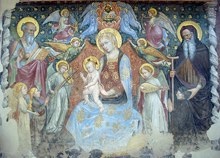
This fresco, which is the masterpiece of Ottaviano Nelli, is encased in a sandstone tabernacle (1510) on the right wall. The inscription, which is now difficult to read, has been transcribed as:
OTTAVIAN(US) MARTIS EUGUBINUS PINXIT A.D.MCCCC(..)III
The missing letter in the date could be V or X, so the work probably dates to 1408 or 1413.
The fresco takes its name from the loggia under which the Madonna and Child are seated. These figures are surrounded by musical angels, and SS Emilianus (?) and Antony Abbot, who present the kneeling donors from the Pinoli family. Cherubs above crown the Madonna under the gaze of the Eternal Father.
Frescoes on the Counter-Facade (early 15th century)
Three frescoes on the counter-facade are attributed to Ottaviano Nelli and/or his workshop:
-
✴the Crucifixion, which is dated by a barely legible inscription to 1404 or 1407;
-
✴St Catherine of Alexandria; and
-
✴the Madonna del Latte, which depicts the Madonna and Child enthroned with SS James and Antony Abbot and a female martyr.
Works in San Francesco
The following works in the left apse of San Francesco are attributed to Ottaviano Nelli:
Scenes from the Life of the Virgin (1408-13)
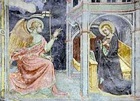
Madonna della Misericordia (15th century)
In 1896, the Madonna’s eyes in this altarpiece were seen to move.
Frescoes (15th century)
These frescoes on the pilaster to the right depict:
-
✴the Mystical Marriage of St Catherine of Alexandria;
-
✴St Christopher;
-
✴St Antony Abbot; and
-
✴the dead Christ with instruments of the Passion.
Works in Sant’ Agostino
Works in Sant’ Agostino that are attributed (at least in part) to Ottaviano Nelli and/or his workshop include the following:
Last Judgement (early 15th century)
This fresco on the chancel arch was rediscovered in the restoration of 1901. It was restored again on two occasions: in 1965; and in 2003. It seems that the fresco was executed in two phases:
-
✴The upper part of the fresco, which depicts Christ in Judgement, with Apostles enthroned to the sides and kneeling saints below them, is attributed to Ottaviano Nelli and his workshop.
-
✴The lower part,which is attributed to one or both of Lorenzo and Jacopo Salimbeni working with (and probably under) Ottaviano Nelli, includes: the resurrection of the dead (at the centre); the reception of the saved by SS Peter and Paul and the celestial vision (on the right); and the descent of the damned into Hell (on the left).
Fabrizio Cece and Ettore Sannipoli (referenced in the page on the church) suggest that the lower part of the fresco was painted after the death of Lorenzo Salimbeni in 1420 and therefore attribute it largely to his brother Jacopo. Mauro Minardi (referenced in the page on the Salimbeni brothers) believes that it was painted in ca. 1410 and attributes it to Lorenzo Salimbeni.
Frescoes (early 15th century)
The frescoes to the right on the chancel arch (below the fresco of the Last Judgement) are attributed to Ottaviano Nelli. The visible fragments depict the Madonna and Child enthroned and St John the Baptist.
Scenes from the Life of St Augustine (ca. 1420)
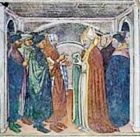
This cycle was fundamental for the development of Augustinian iconography, and many of the scenes also throw light on daily life in Gubbio in the early 15th century. The frescoes were restored in 1965.
Madonna delle Grazie (ca. 1420)
An inscription to the right of the altar of the 3rd altar on the right records that its altarpiece includes a fresco that was detached from a column (probably the 3rd pilasters on the right) in 1647:
-
✴The detached fresco, which is attributed to Ottaviano Nelli or his workshop, depicts the Madonna and Child seated on the ground, with two musical angels to the sides and two other angels below presenting souls in Purgatory to them. A female saint, possibly St Martha, stands to the side.
-
✴The 17th century additions include:
-
•a dove representing the Holy Spirit, above; and
-
•two angels holding a scroll with the inscription “GRATIA MTER” below.
SS Christopher, Ubaldus and Sebastian (15th century)
This detached and damaged fresco in the 6th chapel on the right, which was discovered in 1958, is attributed to Ottaviano Nelli and his workshop.
Madonna della Piaggiola (early 15th century)
This fresco, which is attributed to Ottaviano Nelli, seems to have been painted for the Abbazia di San Pietro. The monks gave it to what was then the Oratorio di Santa Maria della Piaggiola in 1454. It is now on the high altar of the present church: an inscription on the wall to the left of the first chapel on the left records that it was moved here from the earlier church in 1624.
In this unusual iconography, the Madonna holds a small but mature figure of Christ, who in turn holds a scroll with a text that translates: “I am the light of the world: He who follows me shall not walk in darkness”.
Unfortunately, this important fresco has been heavily repainted.
Frescoes in Palazzo Beni (early 15th century)
A number of frescoed coats of arms in the smaller courtyard of Palazzo Beni are attributed to Ottaviano Nelli. Following their restoration, it became clear that:
-
✴the frescoes post-date the marriage of Duke Guidantonio da Montefeltro and Caterina Colonna in 1424; and
-
✴the arms of Pope Eugene IV were painted over an older fresco, presumably after his accession in 1431.
Other monochrome frescoes attributed to Ottaviano Nelli were detached from the main room on the piano nobile of the palace in 1898 and are now in the Raccolta Cagnola alla Gazzada, near Varese.
Scenes from the Life of St Peter Martyr (15th century)
These frescoes in San Domenico (in the 2nd chapel on the left) were recovered in a restoration of 1922. They are traditionally attributed to Ottaviano Nelli.
Madonna and Child (15th century)
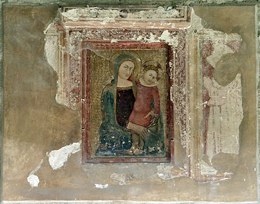
This small fresco, which is attributed to Ottaviano Nelli, was detached in 1904 from the cell of the Blessed Arcangelo in Sant’ Ambrogio and is now in the Cappella di San Sebastiano behind San Secondo.
Nelli’s House
A house art the junction of Via XX Settembre and Via Mastro Giorgio (see Walk I) apparently belonged to Ottaviano Nelli.
Coronation of the Virgin (15th century)
This fresco in the aedicule on the exterior wall is attributed to Ottaviano Nelli.
Madonna and Child enthroned (15th century)
This fresco above the so-called Fonte di Dante (1863-4) in Via Dante (see Walk I), which depicts the Madonna and Child enthroned with saints and angels, is attributed to Ottaviano Nelli.
To be checked
[Fresco (15th century) of St Christopher and the baby Jesus in San Nicolò dei Cappucini attributed to Ottaviano Nelli]
[Convento delle Cappuccine: Madonna and Child attributed to Ottaviano Nelli]
[A fresco (15th century) of the Annunciation that is attributed to Ottaviano Nelli survives in a private house in via Mazzatinti/ Reposati (Walk I). A fragment of a figure of St Louis of Toulouse with the same attribution, which was detached from this house in 1898, passed to the Perkins Collection and is now in the deposit of the Galleria Nazionale, Perugia]
Assisi
Maestà with saints (1422)
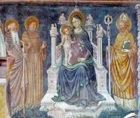
Frescoes from the Ospedale dei Pellegrini (ca. 1422)
The Ospedale dei Pellegrini, which belonged to the Confraternita di SS Antonio e Giacomo, was demolished in 1833, although its chapel, the Oratorio dei Pellegrini, survives. A number of frescoes that were detached from the facade the hospice before its demolition are now in the Pinacoteca. These include:
-
✴the Madonna and Child enthroned with SS James and Antony Abbot and kneeling donors (ca. 1422) by Ottaviano Nelli;

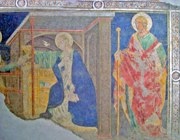

-
✴two frescoes (ca. 1422) attributed to the workshop of Ottaviano Nelli, which depict:
-
•the Virgin of an Annunciation and St James; and
-
•St Lucy.
Città di Castello
Assumption of the Virgin (ca. 1436)
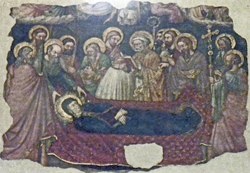
This fresco in the chapel to the right of the nave in Santa Maria delle Grazie is attributed to Ottaviano Nelli. It was discovered under plaster on the right wall of the church in 1630 and moved to this chapel soon after.
Foligno
Frescoes in Palazzo Trinci (1424)
An inscription on the altar wall of the Chapel of Palazzo Trinci records that Corrado III Trinci commissioned the frescoes from Ottaviano Nelli in 1424. This was the moment when Corrado become the sole ruler of Foligno, after the murder of his brothers.
Bottom Register on Altar Wall
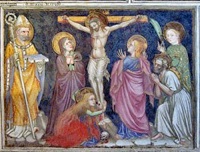
The central fresco here depicts the Crucifixion with:
-
✴the Virgin and St Felician to the left;
-
✴St Mary Magdalene at the foot of the Cross; and
-
✴St John the Evangelist, the Blessed Peter Crisci (in white) and St Catherine of Alexandria to the right.
The other frescoes here depict:
-
✴SS Dominic, Antony Abbot and John the Baptist (on the left); and
-
✴the stigmatisation of St Francis (on the right).
Scenes from the life of the Virgin
This cycle, which covers the rest of the walls and also the vaults of the chapel, follows the story of the Virgin’s life that is set out in the Golden Legend. The scenes depict:
-
✴the marriage of Anna and Joachim in the temple;
-
✴the annunciation of the imminent birth of a daughter;
-
✴the reunion at the Golden Gate; the birth of the Virgin;
-
✴the presentation of the Virgin in the temple;
-
✴the marriage of the Virgin; the Annunciation; the Nativity;
-
✴the Adoration of the Magi; the Presentation of Jesus in the temple;
-
✴the annunciation of the death of the Virgin;
-
✴the arrival of the Apostles to take their leave of the Virgin;
-
✴Christ collecting the soul of the Virgin; the funeral of the Virgin; and
-
✴the Assumption of the Virgin.
Perugia
Pietralunga Polyptych (1403)
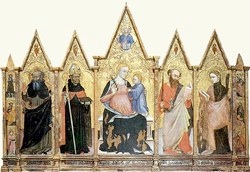
The inscription records that the heirs of Pietro Corsutio commissioned this polyptych from Ottaviano Nelli in 1403. It was discovered in the loft of the church of Sant' Agostino, Pietralunga in 1896 and transferred to the Palazzo Comunale, Gubbio. It was acquired by the Galleria Nazionale in 1954.
The central panel depicts the Madonna and Child enthroned. The other panels depict:
-
✴SS Antony Abbot and Augustine (to the left); and
-
✴SS Paul and Catherine of Alexandria (to the right).
The gable above the Madonna and Child contains a three-headed representation of the Trinity, while the corresponding figures in the other gables are Seraphim.
The polyptych is described in more detail in the website of the Commune of Pietralunga.
Vision of St Brigid of Sweden (15th century)
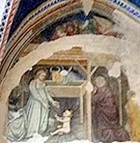
Read more:
M. Silvestrelli, “NELLI, Ottaviano” (2013) Dizionario Biografico degli Italiani (Treccani)
Return to Art in: Assisi Città di Castello Foligno Gubbio Perugia.

